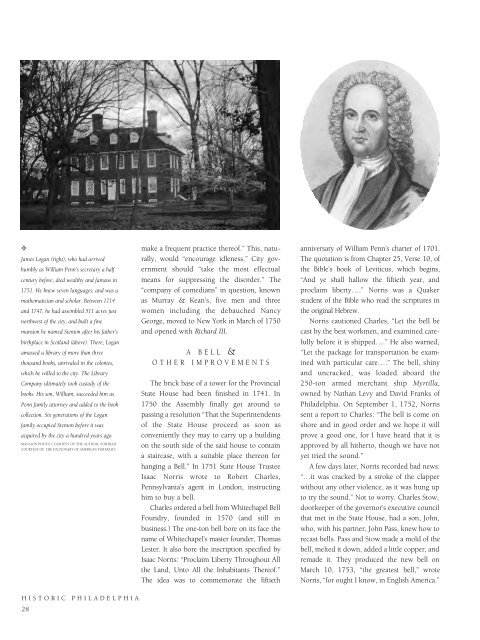Historic Philadelphia
An illustrated history of the city of Philadelphia, paired with the histories of companies, families and organizations that make the region great.
An illustrated history of the city of Philadelphia, paired with the histories of companies, families and organizations that make the region great.
You also want an ePaper? Increase the reach of your titles
YUMPU automatically turns print PDFs into web optimized ePapers that Google loves.
✧<br />
James Logan (right), who had arrived<br />
humbly as William Penn’s secretary a half<br />
century before, died wealthy and famous in<br />
1751. He knew seven languages, and was a<br />
mathematician and scholar. Between 1714<br />
and 1747, he had assembled 511 acres just<br />
northwest of the city, and built a fine<br />
mansion he named Stenton after his father’s<br />
birthplace in Scotland (above). There, Logan<br />
amassed a library of more than three<br />
thousand books, unrivaled in the colonies,<br />
which he willed to the city. The Library<br />
Company ultimately took custody of the<br />
books. His son, William, succeeded him as<br />
Penn family attorney and added to the book<br />
collection. Six generations of the Logan<br />
family occupied Stenton before it was<br />
acquired by the city a hundred years ago.<br />
MANSION PHOTO COURTESY OF THE AUTHOR. PORTRAIT<br />
COURTESY OF THE DICTIONARY OF AMERICAN PORTRAITS.<br />
HISTORIC PHILADELPHIA<br />
28<br />
make a frequent practice thereof.” This, naturally,<br />
would “encourage idleness.” City government<br />
should “take the most effectual<br />
means for suppressing the disorder.” The<br />
“company of comedians” in question, known<br />
as Murray & Kean’s, five men and three<br />
women including the debauched Nancy<br />
George, moved to New York in March of 1750<br />
and opened with Richard III.<br />
A BELL &<br />
OTHER IMPROVEMENTS<br />
The brick base of a tower for the Provincial<br />
State House had been finished in 1741. In<br />
1750 the Assembly finally got around to<br />
passing a resolution “That the Superintendents<br />
of the State House proceed as soon as<br />
conveniently they may to carry up a building<br />
on the south side of the said house to contain<br />
a staircase, with a suitable place thereon for<br />
hanging a Bell.” In 1751 State House Trustee<br />
Isaac Norris wrote to Robert Charles,<br />
Pennsylvania’s agent in London, instructing<br />
him to buy a bell.<br />
Charles ordered a bell from Whitechapel Bell<br />
Foundry, founded in 1570 (and still in<br />
business.) The one-ton bell bore on its face the<br />
name of Whitechapel’s master founder, Thomas<br />
Lester. It also bore the inscription specified by<br />
Isaac Norris: “Proclaim Liberty Throughout All<br />
the Land, Unto All the Inhabitants Thereof.”<br />
The idea was to commemorate the fiftieth<br />
anniversary of William Penn’s charter of 1701.<br />
The quotation is from Chapter 25, Verse 10, of<br />
the Bible’s book of Leviticus, which begins,<br />
“And ye shall hallow the fiftieth year, and<br />
proclaim liberty….” Norris was a Quaker<br />
student of the Bible who read the scriptures in<br />
the original Hebrew.<br />
Norris cautioned Charles, “Let the bell be<br />
cast by the best workmen, and examined carefully<br />
before it is shipped….” He also warned,<br />
“Let the package for transportation be examined<br />
with particular care….” The bell, shiny<br />
and uncracked, was loaded aboard the<br />
250-ton armed merchant ship Myrtilla,<br />
owned by Nathan Levy and David Franks of<br />
<strong>Philadelphia</strong>. On September 1, 1752, Norris<br />
sent a report to Charles: “The bell is come on<br />
shore and in good order and we hope it will<br />
prove a good one, for I have heard that it is<br />
approved by all hitherto, though we have not<br />
yet tried the sound.”<br />
A few days later, Norris recorded bad news:<br />
“…it was cracked by a stroke of the clapper<br />
without any other violence, as it was hung up<br />
to try the sound.” Not to worry. Charles Stow,<br />
doorkeeper of the governor’s executive council<br />
that met in the State House, had a son, John,<br />
who, with his partner, John Pass, knew how to<br />
recast bells. Pass and Stow made a mold of the<br />
bell, melted it down, added a little copper, and<br />
remade it. They produced the new bell on<br />
March 10, 1753, “the greatest bell,” wrote<br />
Norris, “for ought I know, in English America.”
















